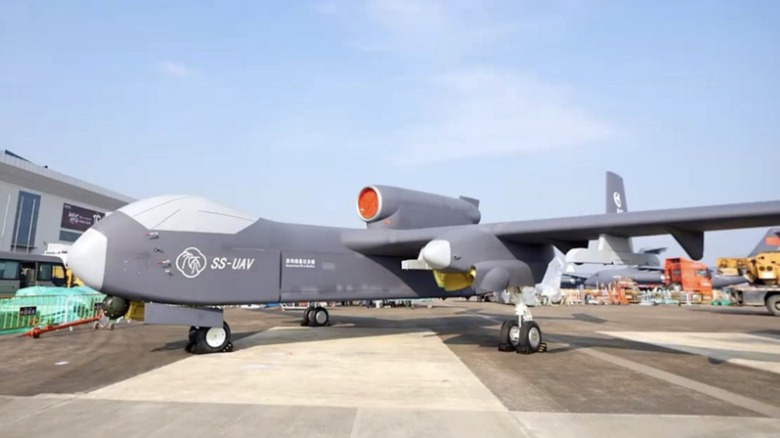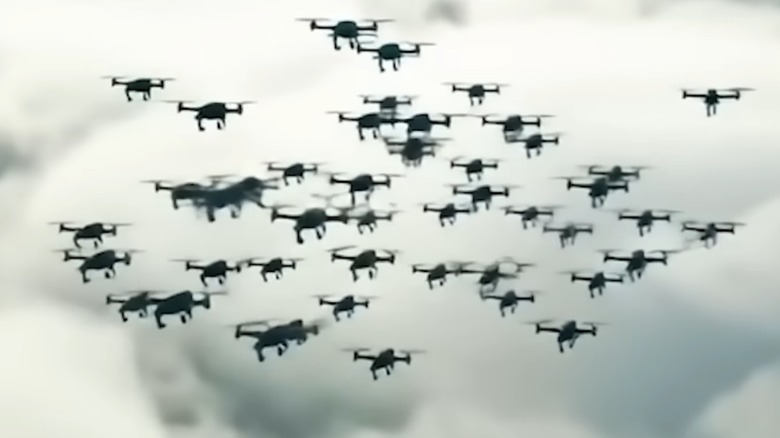China's New Drone Mothership Could Shift The Balance In Its Favor
The 21st century has seen a shift in military combat, with some of the best military drones now taking center stage. This is especially true of the Russo-Ukrainian War, which has involved drones on both sides. Ukraine's ingenuity, in particular, has caused widespread destruction to its enemy. Many of these drones are inexpensive single-use vehicles capable of destroying tanks, strategic bombers, or whatever happens to be in their way.
While there are many military drones with long ranges, first-person view (FPV) drones can only travel limited distances. This presents a problem that China is looking to overcome via a new type of drone dubbed a "mothership." It is capable of flying to a target area to unleash a fleet of FPV drones to strike targets that would otherwise be out of range. Other nations, including Ukraine, are developing similar drone aircraft carriers, but China appears to be at the forefront of this innovation.
China unveiled its Jiu Tian "High Sky" SS-UAV drone mothership in November 2024 at the Zhuhai Air Show, and it looks to be an interesting design. The plan is to begin operating the Jiu Tian at the end of June 2025. Should it prove to be a viable aircraft capable of delivering a fleet of drones as advertised, it could conceivably shift the balance of power regarding drone innovation in China's favor. While China has revealed little information about the aircraft thus far, what has been shown suggests that this is a serious possibility, and military planners in the West have taken notice.
The Jiu Tian SS-UAV drone mothership
On the surface, the Jiu Tian is a massive beast of a drone that should be susceptible to air defense systems. However, it's not intended to fly directly into combat. The whole point of a drone mothership is to extend the range of its onboard drones, and the Jiu Tian is designed to do just that. It can carry 100 UAVs that it can release to engage a variety of targets, or it can be modified to carry around 2,200 pounds of missiles.
At this year's #AirshowChina, #China's new Jiutian multi-role #UAV made its debut! This heavy-duty #drone isn't just for recon—it doubles as a transport, carries missiles, and can even deploy smaller drones. #AirshowChina2024 pic.twitter.com/dD7OtKGgEK
— Shanghai Daily (@shanghaidaily) November 12, 2024
That said, it's unlikely it will be relegated to missile delivery when China already has or is developing drones capable of doing so. The Jiu Tian is massive, with an 82-foot wingspan and a maximum takeoff weight of 16 tons. It has a range of 4,350 miles and can fly for 36 hours with a maximum ceiling of 50,000 feet. That said, some observers in the West aren't intimidated by the Jiu Tian, with retired U.S. Air Force pilot and X user MCCCANM suggesting that "it's not remotely survivable [and] a gigantic missile magnet. This is just classic propaganda."
While that may be true, it's unlikely the Jiu Tian would be used in a battlespace where China lacks air superiority. China could also take additional steps to ensure it survives long enough to deliver its drone payload. If used as designed, the Jiu Tian would function as a force multiplier for China and, like many drones, will also function as an intelligence, surveillance, and reconnaissance (ISR) platform wherever it operates.
What it all means
China's Jiu Tian boasts an interesting design, and it could conceivably become a new standard in kamikaze or FMV loiter munition deployment as the world's first flying aircraft carrier. In December 2024, China placed an order for nearly a million kamikaze drones, so it's taking this development seriously. Still, Jiu Tian's effectiveness in combat operations will be determined by who or what it targets. In a conflict with a nation like the United States, which boasts impressive air defense systems, it's unlikely the Jiu Tian would be effective. In a war with a less capable adversary, the drone could conceivably offer China a combat advantage.
One way the Jiu Tian could be used to overcome air defenses is via a mass deployment. It could pose a serious threat if a fleet of these motherships were to close in on a target area and release swarms of 100 drones each. One of the primary benefits of short-range FPV drones is cost, as they're considerably cheaper than more advanced models. Taking out a military asset valued at millions of dollars with a drone costing a few thousand is one of the ways Ukraine's drone warfare has beleaguered Russia's efforts in its country.
China could unleash thousands of these cheap drones on a target, which would be difficult to defend against. Shooting down these types of drones is becoming more important as development continues, and while China hasn't revealed the specifics of what the Jiu Tian will carry and unleash, odds are that shooting them all down will pose a problem. If used in that capacity, it's entirely feasible that the Jiu Tian could be employed against near-peer adversaries, ensuring China retains regional superiority in Asia.


